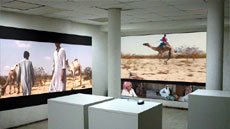 "This, ladies and gentleman, is the world!" and with
that, Florian Thalhofer began to show us his interpretation of what the world is. Like he
said, the real world is gigantic. One person is a very small component. If a person
traveled the globe, they would develop opinions on the places they visited. Having done
this, one might feel that they know the world, but they actually only know small segments.
Thalhofer knows he can only present fragments to his audience, and works within this
understanding. "This, ladies and gentleman, is the world!" and with
that, Florian Thalhofer began to show us his interpretation of what the world is. Like he
said, the real world is gigantic. One person is a very small component. If a person
traveled the globe, they would develop opinions on the places they visited. Having done
this, one might feel that they know the world, but they actually only know small segments.
Thalhofer knows he can only present fragments to his audience, and works within this
understanding.
As he points out, traditional, or so-called normal films, have a logical sequence of
scenes assembled to help progress a linear story. But that's not how the world operates.
One thing does not follow another in a perfect line. To reflect this reality, he takes
scenes, describes them, and then relates those with other ones so in the end he doesn't
create a film - he creates an experience.
Right now, he has three works on display in the FADA Exhibition Hall. One is an
instillation that revolves around the life of Bedouins on the Sinai Peninsula. To present
his film work, he incorporates two screens connected to one another. Both screens show
variations of the film footage he has shot. One side may show the raw, unedited version of
a clip, while at the same time the other screen may show an edited version of the
identical footage. For the viewer, this means that the presentation is never the same
twice. Each time, one sees a different combination of images, though they are always
related. Thalhofer plays with his medium in a very effective way. While not following any
of the traditional rules of story telling or film making, he is still able to tell a tale
and create an informative and engaging end product.
Thalhofer's shopping mall project was created with the idea that anything can be used as a
subject. In the film making process, he went to a mall and watched the people, saw what
has happening, and interviewed those who hung out there. He found that it was a perfect
place to collect stories - after all, it's the people that make a shopping mall a
"shopping mall," and it is them that make the piece a success.
Beyond showing and discussing his art, students had the opportunity to attend an
interactive workshop in the Communications and Design Departments BITS television studio.
Florian Thalhofer took time to introduce and illustrate the use of his personally designed
Korsakow software that he uses to create his works.
Thalhofer has assembled an interesting and challenging exhibition, and it was a pleasure
to have the artist himself on hand. The Bilkent Community has had the chance to get up
close and personal with him as the result of cooperation between the Bilkent University
Department of Communication and Design (COMD), and the German Cultural Center (Goethe
Institute). If you'd like to find out more on Florian Thalhofer, visit http://istorybox.thalhofers.net/
Alev Dešim (COMD/III)

|







